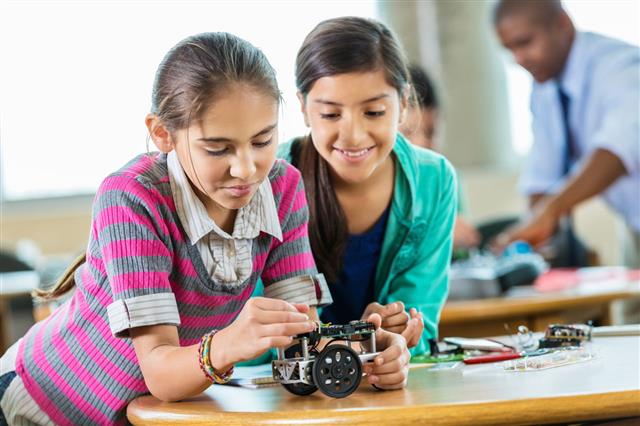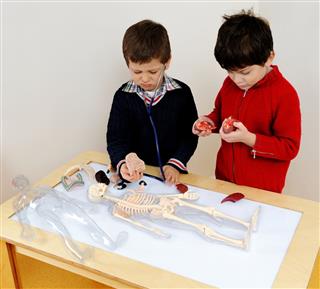
To start a project, you can think of interesting topics (maybe related to your theory class) and note them down as statements or hypothesis. Then, you can plan an experiment, keeping in mind the requirements and procedure to be followed for that particular project. Once you are sure about the protocol, perform the experiment and draw out the possible observations. Based on the observations and results, you can prepare the conclusion.
In a science fair project, each of the participating students gather to demonstrate and present their works. A project can also be handled by a group of students, depending on the complexity level and/or time duration required to submit the project. A science fair project is nothing but the creation of a setup to demonstrate the application of scientific knowledge or theory/theories in order to answer common queries or solve common problems. The basic concept of such projects is to enhance the knowledge of the students by allowing them to create and experiment with innovative ideas related to science.
For this project, you can compare the human anatomy of the two stages and study the result. You can also study the classification of bones into long, short, flat, and irregular bones along with examples of each category.
Are you aware that humans have more bones as children than as adults? Yes, it is true. A baby has more than 270 bones at birth and as he/she grows into an adult, the number of bones reduces to 206 separate ones. Of these, the largest is the femur bone. The reduction in number is due to the fusion of some bones, which takes place as a part of the development process.
For this project, take three popular soap brands and prepare a solution with water for each type. Make sure you take the same quantity of soap and water each time. Take four petri dishes and place a filter paper in each of them. Soak wheat grains overnight and grow a fixed number of wheat seedlings in each petri dish. Label the petri dishes with the soap name and use one for control condition, which you can mark it as ‘water’.
You will be using plain water in the control petri dish. Add 5 – 8 drops of water and/or soap solution twice daily, respective to the petri dish label. Note down the observations (root and shoot length) everyday after seed germination. Within a week, you will notice the difference in the growth of the seedlings for each soap type. Based on the data, prepare a graph and present the project.
Collect four soil samples from different areas and don’t forget to label them. Take four bottles and prepare soil solutions by mixing soil with water. Take the same amount of soil and water each time. Close the bottle lids and keep them in areas where adequate light is available. After about 10 days, you will notice the growth of algae (green coloration) in the bottles.
You can study them with the help of compound microscopes. The more the number of organisms, the more healthy is that particular soil sample. This way, you can compare the soil samples for fertility.
For this plant cell experiment, take simple algal species, like spirogyra or chlorella. You can consult your class teacher and ask for any one of these. Prepare a hypertonic (higher concentration) salt solution and keep the alga in this solution for about 15 – 20 minutes. Then, observe the treated alga under a microscope.
You will find the cell becoming constricted due to the process of osmosis. In this case, due to high salt concentration, water from the cell moves to the surrounding areas, resulting in a plasmolyzed cell. Compare this with another algal specimen of the same species, kept in plain water.
More 8th Grade Science Fair Project Ideas
~ Which types of wood burn at a faster rate and why? You can take softwood and hardwood samples for the project.
~ What are the possible impacts of acid rain on buildings, monuments, crops, ecosystem, and overall environment?
~ Pesticide runoff from cultivated areas is a major contribution to environmental pollution. Are there ways to decrease the use of pesticides for growing crops?
~ What can you do to fasten the germination time of hard seeds? Over here, you can use the methods of soaking in cold water, soaking in hot water, chemical treatment, and poking holes in the seed coat.
~ Are you aware about the presence of microbes in our mouth? Prepare a petri dish with a nutrient medium, blow air to it, incubate for some days, and check out the microbial colonies.
~ Examine the presence of bacteria and microbes (if any) in pasteurized and unpasteurized milk samples. According to the result, you can conclude the safety of milk for consumption.
~ Which fruits and vegetables have the greatest charge? For this, you will require a multimeter and some commonly found fruits and veggies.
~ Does presence of salt in water affect the process of ice formation? Check out whether it slows down or fastens condensation.
~ For washing clothes, does the amount of detergent affect the result? Is it best to use the amount recommended in the product package?
~ What is the phenomenon behind blue coloration of the sky? In addition, try to find out the color of mountains and water bodies from far away.
~ Is there any difference between the stars that we see in the sky? And what about the successive stages of the stars?
~ Try a chromatography experiment to find out the constituents of a mixture. With this, you can separate the active ingredients of a plant extract.
~ Analyze phototaxis in plants and animals. You will find positive for plants, while animals can exhibit either positive or negative phototaxis.
~ Is there any correlation between decreased transpiration in plants and presence of pollutants in the atmosphere? Does increased air pollution affect the stomatal openings?
~ Is it possible to graft a tomato stem onto the rootstock of a potato plant? You can conduct this project with other shoot and root vegetables.
~ Grapefruits are very juicy fruits, but how much amount of a grafefruit is water? The result is most likely to fall between 60 – 80 percent.
~ To examine how a volcano erupts in nature, you can make an erupting volcano with easily available supplies for your science fair project.
~ Study the effects of heat on the rate of evaporation of water. For this project, you can use bulbs of different watts (25, 40, 60, and 75 watts) as heat sources.
~ Is there any connection between wound healing and applying band aids? Which one heals faster, with band aids or without band aids?
~ How do nocturnal animals hunt food in the dark? You can check out the adaptations of some commonly known nocturnal birds and animals for the science fair project.
~ Are there nutritional differences in the canned, fresh, and dried forms of the same vegetable? If yes, which is the most nutritious type for consumption?
~ Study the reliability of sterilization techniques for killing pathogens from glassware and equipment in hospital settings. The findings will be useful for preparing sterile nutrient media and performing other scientific experiments.
~ Do you know magnets negatively affect plant height? You can plan an experiment for your science fair project out of this too.
~ Is there any connection between the lung capacity of an individual and increasing age? If there is, study the reasons behind it.
~ Study the effect of temperature on the growth rate of caterpillars. It is expected that caterpillars grow faster at a higher temperature and vice versa.
~ In an experiment for growing crystals, what factors affect the crystal size? You can check for humidity, regular shaking, growth medium, and time as factors.
~ Which barren land will erode faster, soil in a steep slope and soil in a lesser slope angle? The result will be soil in a greater slope angle.
~ For a windmill to produce more electricity, which type of blade should you use? You can add other aspects as well, like height, angle, and design of the propeller.
~ Traces of fluoride are present in municipal drinking water. But, what about the negative effects of fluoride on the tooth enamel?
~ What is the role of soil microbes in increasing the fertility of soil? Which one is better for growing plants, soil with less microbes or soil with more microbes?
~ Is it feasible to use solar energy, wind energy, and geothermal energy in the long run? Explain their advantages and disadvantages.
~ Which types of natural preservatives work the best for increasing shelf life of food? How do they affect the growth of microbes?
Well, these were some 8th grade science fair project ideas. In the project, one can make use of posters (pictures, graphs, and charts) relevant to the particular experiment. And while explaining the project or answering any query, you can refer to these posters for better understanding. In case of a time-consuming experiment, you can skip some steps that can be explained by using the posters. That way, you can make the project short and interesting to present. Anyway, a very lengthy project sounds boring to the presenter as well as to the viewers. So, consider these aspects to make your project an award-winning one in the competition.
























